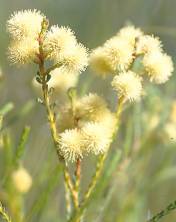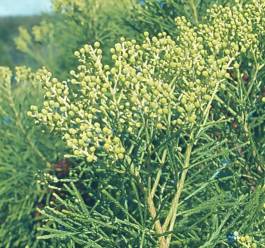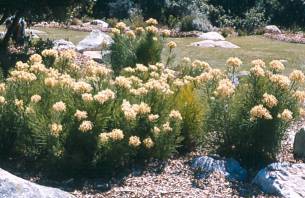Berzelia lanuginosa
Berzelia lanuginosa (L.) Brongn.
Family: Bruniaceae
Common names: common button bush, common berzelia (Eng.); vleiknoppiesbos, vleikolkol, kolkolbos (Afr.)
Introduction
Berzelia lanuginosa is one of twelve species in the genus Berzelia in the Bruniaceae, one of the few families that is endemic to the Cape floral kingdom and the Western Cape.

Description
Description
Berzelia lanuginosa is an evergreen shrub that grows up to 2 m high. It has slender branches and a spreading or upright habit. The small, narrow leaves are closely arranged in whorls up the stem. The flowers are usually clustered in terminal heads on short branches. The flower colour is creamy white to yellow, and flowers from June to November. After flowering, it has attractive, green to reddish seedheads, which stay on the shrub for a year or two.

Distribution and habitat
Distribution description
The natural distribution of Berzelia lanuginosa is from the northwestern to the southwestern parts of the Western Cape, between Clanwilliam and Bredasdorp. It occurs on sandy flats and slopes in permanently moist sites (seepages). Berzelia lanuginosa is a good indication of boggy areas.
Derivation of name and historical aspects
History
Berzelia was named in honour of Count Jacob J. Berzelius (1779-1845), a renowned Swedish chemist who was the founder of chemical symbols and was also a professor of medicine. The species name, lanuginosa is derived from the Latin, meaning wool, referring to the fluffy flowerheads.
Ecology
Ecology
Berzelia lanuginosa is insect-pollinated, bees, flies and walking insects are the main pollinators. This species grows within the fynbos biome and it has the same adaptations as fine-leaved fynbos plants.
Uses
Use
Berzelia lanuginosa has no known medicinal or cultural uses. It is, however, a beautiful and relatively hardy species, suitable for growing in pots and seepage areas.

Growing Berzelia lanuginosa
Grow
Berzelia is suitable for outdoor cultivation in areas with a warm, dry and frost-free climate and is amenable to cultivation in the glasshouse. They are compact shrubs with neat foliage, grown for their crowded, rounded heads of creamy flowers produced in late spring to summer.
Grow in a moist but well-drained, lime-free medium that is rich in organic matter. Position in full sun to part shade in cool, well-ventilated conditions. Unless seed is required, deadhead and prune lightly after flowering to maintain a neat shape and compact habit.
Sow seed in autumn, dust seed with a fungicide to prevent pre- and post-emergence fungal infections. It responds well to smoke treatment and germination may take 6 to 8 weeks.
Propagate by semi-hardwood cuttings in late summer to autumn and spring, in 50/50 rooting medium of milled bark and polystyrene. The plants should be treated with a rooting hormone and placed on heated benches with an overhead mist spray. Cuttings are not as successful as seed.
References
- Brown, N.A.C. & Botha, P.A. 2004. Smoke germination studies and a guide to seed propagation of plants from the major families of the Cape Floristic Region, South Africa. South African Journal of Botany 70: 559-581.
- Jackson, W.P.U. 1990. Origins and meanings of names of South African plant genera. University of Cape Town Printing Dept., Cape Town.
Credits
Roger Tuckeldoe
Kirstenbosch NBG
March 2005
Plant Attributes:
Plant Type: Shrub
SA Distribution: Western Cape
Soil type: Sandy, Loam
Flowering season: Spring, Early Summer, Winter
PH: Acid, Neutral
Flower colour: White, Cream
Aspect: Full Sun
Gardening skill: Average
Special Features:
Horticultural zones







Rate this article
Article well written and informative
Rate this plant
Is this an interesting plant?
Login to add your Comment
Back to topNot registered yet? Click here to register.